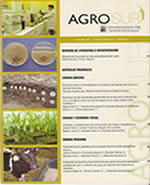Influence of adding liquid smoke on stability and acceptability of smoked sausage
Main Article Content
Abstract
This research is about the influence of liquid smoke on the stability and acceptability of smoked sausage. The product was made based on an ingredient formula. Three levels of liquid smoke (0.3; 0.6 and 0.9%) along with a control treatment (0.0 %) were studied. Four replications for each treatment were performed. The finished product was stored under refrigeration at 4 °C in plastic trays wrapped with polyethylene film. Product characterization included the content of protein, fat, moisture and ash. Also, an acceptability study was performed through sensory analysis of the following organoleptic parameters: flavor, aroma, color, texture and appearance. Subsequently, a stability study was conducted at ambient conditions (4 °C, 60% RH), evaluating microbiological parameters (Escherichia coli, total coliform and fungi) as well as the mentioned organoleptic parameters. Shelf life was determined for each of the treatments. These analyzes were performed on days 0, 10, 20 and 30. For analysis of the results, statistical tests were conducted in order to determine the existence of statistically significant differences between treatments. Finally, it was possible to demonstrate the efficacy of liquid smoke as a food preservative, with increasing concentration of liquid smoke, a significant decrease in microbial contamination occurred. Moreover, treatment with 0.6% liquid smoke had the most stable organoleptic parameters, with a product’s shelf life of 43 days.

